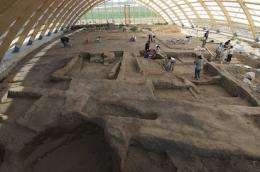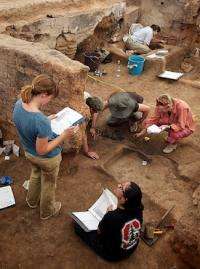Stanford archaeologist questions the role of human rights in site preservation

In the arid, rural plains of central Turkey sits one of the most important archaeological sites on earth. Sheltered by an expansive glass canopy, dozens of archaeologists and students work year-round to unearth and preserve the treasures of the ancient village of Çatalhöyük. Since 1993 Stanford professor of anthropology, Ian Hodder, has been leading an international team in an ongoing excavation of the 9,000 year-old Neolithic site.
Visible from the edges of the site are the low-slung buildings of the villagers who call Çatalhöyük home today. For the surrounding community the site represents the history of their ancestors. For academics and preservationists the site is a priceless window into the shared history of human civilization. The site is a meaningful symbol of cultural heritage to both groups, but they view it differently, and these views have important implications for basic human rights.
In recent years, there has been a growing movement within archaeological circles to define historic sites by their links to the human rights of the indigenous populations. Because archaeology is the study of the human experience across history, an increasing number of archeologists maintain that the connection to human rights (especially those of cultural heritage and education), is perfectly natural as these are intrinsic components of the right to learn one’s history.
This view, for instance, has enjoyed much success within forensic archaeology, which uses field techniques to locate and recover victims of human rights abuses. In other realms of archaeology, however, the approach of classifying historic site excavations as a human rights mission is much more complex. Professor Hodder argues it is less successful at preserving the history of the site than a traditional approach of applying for protection from an international organization, like the United Nations, which protects the found objects at a site.
With support from the Stanford Presidential Fund for Innovation in International Studies, Hodder explored this contested connection in the Program on Human Rights Collaboratory, an interdisciplinary investigation of human rights in the humanities.
Çatalhöyük: A Case Study in Complexity
Hodder, Director of the Stanford Archaeology Center between 2006 and 2009, presented his findings to a group of archaeology students this fall. During the presentation he explained “the issue with validating the archaeology site at Çatalhöyük, for example, as a ‘human right’ is that discourse among different cultures becomes conflicted.” Hodder further argued that the basic trouble of approaching preservation from a human rights perspective is that the critical emphasis is placed on which group has the right to control and preserve the past. As a result, rights approaches to heritage are often legalistic, oppositional and exclusionary rather than promoting sharing and participation in heritage.

Citing his experience at Çatalhöyük, Hodder explained that the Western concept of cultural heritage and all it entails, such as teaching national history in school, could infringe on what is considered ‘cultural heritage’ in a site’s surrounding community. For instance, as Hodder pointed out, while including education about Çatalhöyük’s history in local schools seems, from a Western point of view, like a basic human right, the devout Islamic community around Çatalhöyük, “would consider it a threat to their rights because it detracts away from the traditional curriculum of the Kor’an in which prehistory is not taught.”
Last summer UNESCO (United Nations Educational Scientific, and Cultural Organization) sent a team to Çatalhöyük to do a traditional site evaluation, which focuses solely on the academic and historical merit of a site. If the evaluation were successful, then Çatalhöyük would be one step closer to becoming a world heritage site and would enjoy the protection from any threats of modernization. Hodder noted that contrary to what one might expect, UNESCO’s emphasis on the objects instead of the rights of the local people, proved more effective in uniting the two communities.
There had earlier been tensions amongst the various Çatalhöyük stakeholders about how the site should be managed and taught. Religiously conservative groups that are dominant in the local region were suspicious of the approaches and goals of the international team working at the site. After the UNESCO visit, however, these differences were put aside in various cases; for example the local schools planned to integrate their curriculum with those promoted by the European Union.
As professor Hodder recalled, “Channels began to open up and museum plans for the site, which the local government had been quite slow to consider in the past, were quickly approved. There was a dramatic increase in excitement and effort from the community for the site to be approved.”
What caused such a dramatic shift? Professor Hodder believed that the enthusiasm wasn’t so much a result of the community’s desire to impress the Western-oriented UNESCO organization, as it was an interest in having Çatalhöyük recognized for its universal value.
The regional governor went to great lengths to provide hospitality to the visiting delegation and to show that he would work with all stakeholder groups in taking responsibility for the site and its future. While acknowledging that world heritage status would involve complying with rules and regulations set in Paris, he very much wanted his region to be put on the international map.
A Human Rights Approach in Hasankeyf
Referencing Hasankeyf, an archeological site 600 miles to the east of Çatalhöyük as a counter-point, Hodder said the human rights rationale for preservation can sometimes be more effective.
Hasankeyf is another site threatened by the encroachment of the modern world. Similar in many ways to Çatalhöyük the UNESCO emphasis on artifact preservation alone has not been compelling enough to save the site.
Situated on a piece of land that would be destroyed by a government-sponsored dam, Hasankeyf has fueled a fair amount of controversy. In this case, protection by a UNESCO sanction is not available because the same government officials need to approve the UNESCO application.
Temporary success was achieved by focusing on the rights of the local population. Through petitions (most notably from Amnesty International) arguing that destroying the site and forcibly relocating the community around it would violate their rights of land, education, shelter, health and standard of living that the government was pressured enough to put a hold on their plans. In the end a compromise of sorts was reached. The dam will be built but the government has agreed to pay for the relocation of the some of the monuments, preserving at least some of the archaeology of Hasankeyf.
Since the cultural and political circumstances facing Çatalhöyük and Hasankeyf are dramatically different, Professor Hodder commented, “It is difficult to come to a clear conclusion and generalize how good or bad the human rights approach in archaeology can be.”
Yet he did conclude the discussion by emphasizing that in his 25 years of experience at Çatalhöyük he’s seen that a focus on historical artifacts rather than human rights has allowed the local people to protect their varying definitions of human rights.
Provided by Stanford University

















